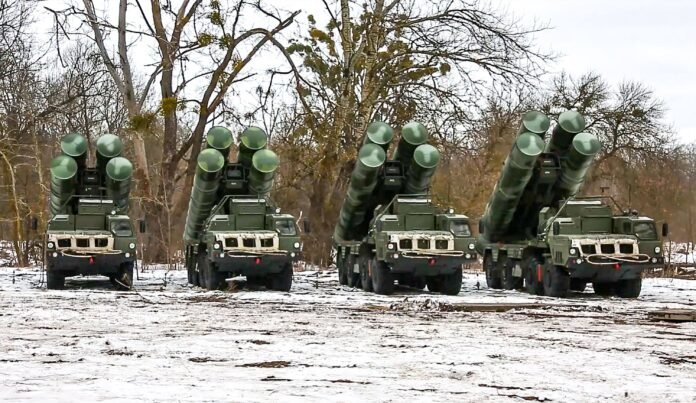India’s long-standing defence relationships were subjected to renewed scrutiny in the years following Russia’s 2022 invasion of Ukraine. For decades, Russia had provided the majority of New Delhi’s main weapon systems, including fighters, tanks, submarines, air-defence systems, and artillery. However, the war and Western sanctions have exacerbated India’s desire for diversification. France and the United States made a commitment and subsequently emerged as significant Western partners, securing high-profile contracts and fostering industrial collaboration. The West had become India’s most significant defence supplier by 2025; however, it had not yet completely replaced Russia as India’s single largest supplier in aggregate terms.
The Post-2022 Shock and Russia’s Enduring Presence
The influence of Russia on India’s military is both structural and enduring. Russian-origin designs, doctrine, and supply channels comprise a substantial proportion of India’s air, land, and naval forces. The conflict in Ukraine raised legitimate concerns regarding spare parts, maintenance, and delivery timelines; however, it did not immediately eliminate the profound logistical and operational dependencies that had developed over the course of decades. Russia maintained sustainment lines, signed support and upgrade deals, and continued to dispatch critical hardware that was essential to India’s operational readiness. Russia maintained its lead in aggregate supply volumes throughout 2024 and into 2025 as a result of these ongoing fluxes.
Russia remained India’s largest supplier through 2025, despite a decline in its proportion from historical highs, as measured by the total value and volume of major conventional arms. France’s proportion of the global arms export market increased significantly, and it became the most significant Western supplier
The Strategic Advantages and Industrial Partnership of the West
Diplomatic momentum enabled the West to achieve tangible industrial victories. In accordance with India’s Make in India objectives, Paris prioritised technology transfer and local production, expanding French aircraft, naval proposals, and aerospace partnerships. A transition from transactional sales to strategic industrial partnerships was indicated by renewed orders and co-development discussions in aviation, submarine construction, helicopter engines, and aerospace components. French firms promoted reciprocal purchases and enhanced local integration, indicating a developing bilateral defence relationship. Politically, France’s approach resonated with New Delhi’s desire for dependable partners who refrained from transactional conditionality. The United States also demonstrated proficiency in subsystems; however, it was unable to provide complete systems, such as aircraft, with the exception of transport, ASW, and attack helicopters.
What the Data Indicates for the Year 2025
Russia remained India’s largest supplier through 2025, despite a decline in its proportion from historical highs, as measured by the total value and volume of major conventional arms. France’s proportion of the global arms export market increased significantly, and it became the most significant Western supplier. India received a significant portion of its global arms exports. India simultaneously increased its defence production and exports, demonstrating a concerted effort to balance foreign procurement with the development of domestic capabilities. The ultimate outcome was a procurement map that was more diverse: Russia continued to be the dominant country in cumulative terms, France was a rapidly expanding and more profound industrial partner, and other Western states and Israel played complementary roles.
Ukraine’s Battlefield Lessons: Western Systems’
Western equipment that was shipped to Ukraine was advertised as having distinct tactical advantages. Modern main battle tanks, advanced infantry fighting vehicles, long-range rocket artillery, and precision-guided munitions were unable to withstand the combined force of Russian electronic warfare, high-tech weapons, and overwhelming numbers. Despite the robust ISR (intelligence, surveillance, and reconnaissance) capability, the weapon systems’ non-performance resulted in limited impact. These armaments initially impeded Russia’s advance, but the Soviet-era defensive structures were the true cause of the slowdown.
Battlefield Lessons from Ukraine: Where Russian Approaches Worked
Simultaneously, Russia’s industrial adaptation and military capabilities demonstrated strengths often overlooked in technical comparisons. The Russian doctrine prioritised the use of massed fires, layered air-defence netting, intensive electronic warfare, and the use of large quantities of cheaper munitions and loitering drones to overwhelm sensors and logistics. Moscow’s wartime industrial response resulted in the expansion of production of artillery rounds, missiles, armoured vehicles, and unmanned systems, which enabled the country to maintain attritional pressure. In numerous operational sectors, Russia’s operational resilience against technologically superior but numerically limited adversary capabilities was provided by the sheer volume of relatively inexpensive ordnance and the capacity to sustain losses.
Ukraine has emphasised a practical reality: high-end platforms provide substantial per-unit combat power; however, their battlefield impact is contingent upon ammunition supply, repair-and-overhaul capacity, secure logistics, and troop numbers. The presence of industrial depth and robust inventories of precision munitions effectively multiplies the impact of sophisticated Western systems
The Interplay of Quality, Quantity and Sustainment
Ukraine has emphasised a practical reality: high-end platforms provide substantial per-unit combat power; however, their battlefield impact is contingent upon ammunition supply, repair-and-overhaul capacity, secure logistics, and troop numbers. The presence of industrial depth and robust inventories of precision munitions effectively multiplies the impact of sophisticated Western systems. In contrast, the technological advantages can be blunted by the attrition costs that are difficult to sustain in the absence of comparable industrial surges, which are imposed by the abundant production of simpler munitions and robust replenishment. Consequently, the conflict highlighted the crucial role of sustainment, encompassing secure supply chains, stockpiles, and factories, in enhancing battlefield performance.
Why France Gained but Did Not Fully Replace Russia
France’s ascent is indicative of its political alignment, targeted industrial cooperation, and high-technology offers that align with India’s modernisation objectives. Nevertheless, the structural inertia that was established by the legacy of Russian matériel, entrenched logistics, doctrinal integration, and ongoing maintenance contracts was unable to be swiftly reversed. France bolstered its influence and became a favoured Western collaborator in development. However, the replacement of Russia’s stock, spare-part networks, and long-term sustainment would necessitate a significant investment, time, and the production of consumables locally, particularly ammunition.

Potential Policy Implications for India
A multilayered strategy is necessary to address India’s strategic requirements. Preserving and modernising Russian-origin capabilities in areas where they serve as the operational backbone maintains immediate readiness. Simultaneously, acquiring Western high-end systems can bridge critical capability gaps and provide technological advancements. Both tracks must match investments in domestic sustainment, including ammunition manufacturing, maintenance depots, local co-production agreements, and training pipelines. By incorporating indigenous production and diversification, this hybrid approach progressively decreases vulnerabilities while ensuring operational continuity.
A multilayered strategy is necessary to address India’s strategic requirements. Preserving and modernising Russian-origin capabilities in areas where they serve as the operational backbone maintains immediate readiness. Simultaneously, acquiring Western high-end systems can bridge critical capability gaps and provide technological advancements
Practical Steps for India
Objective and Immediate Imperative
India must simultaneously mitigate long-term supply vulnerabilities and ensure operational capability across its forces. Ensuring combat-capable and serviceable legacy platforms, along with credible sustainment arrangements for any new acquisitions, is the immediate priority.
Short-term Measures (0–24 months)
Maintain and expand critical Russian supply lines for spares, maintenance, and enhancements in areas where these systems are essential for force readiness. Concurrently, negotiate reciprocal sustainment guarantees in procurement contracts with Western suppliers that explicitly involve consumables, ammunition lines, and the transmission of manufacturing know-how for critical parts. To prevent the types of shortages that occur when advanced systems consume high levels of precision munitions, rapidly increase domestic ammunition stocks through emergency capacity increases and contract manufacturing.
Medium-term Actions (2–5 years)
Establish joint production agreements with Russia, France and other Western partners that prioritise the local production of both platforms and consumables. Invest in a distributed repair-and-overhaul network that is capable of servicing a diverse fleet. Increase workforce training to facilitate the operation of mixed-origin platforms and establish integrated logistics chains that can efficiently transport parts and ammunition between services and theaters.
Long-term Posture (5–10 years)
Aim to establish an industrial ecosystem that can domestically produce strategic volumes of munitions and key subsystems, thereby reducing acute dependence on a single external supplier. To maintain a balanced geopolitical posture, continue engaging in selective procurement from various foreign partners to acquire technological advantages. Use co-development agreements to guarantee that future platforms are developed with Indian sustainability in mind, thereby reducing the number of single-source chokepoints.
Summing Up
Russia’s structural role continued despite the West’s ascent. Moscow continued to fullfil essential sustainment and upgrade contracts through 2024 and into 2025, and a significant portion of India’s current force structure was underpinned by Russian-origin platforms, supply channels, and operational doctrine. The considerable increase in French arms imports and co-development in India was impeded by entrenched logistical dependencies, ongoing upgrade cycles, and the practical realities of force conversion, which impeded Russia’s complete displacement. Consequently, modernisation assumed a hybrid form: it aimed to maintain operational continuity on the Russian backbone while simultaneously pursuing high technology and future readiness through newly strengthened Western partnerships.
India will need a comprehensive plan that involves keeping and improving Russian systems, strengthening partnerships with Western technology and manufacturing, and speeding up local production of necessary goods and equipment
The lessons of Ukraine illustrated the constraints of relying solely on high-technology imports. Sophisticated platforms were not the sole determinant of effective military capability; they were also reliant on reliable logistics, ammunition supply, robust industrial depth, and resilient sustainment networks. The enduring relevance of quantity and quality was underscored by the Russian military’s adaptation and mass production of affordable munitions, whereas the impact of Western platforms was contingent upon the availability of consistent inventories of precision equipment and integrated manufacturing support.
By 2025, India’s defence procurement will have to adopt a pragmatic multi-vector approach. In terms of cumulative impact, Russia continues to serve as the foundation. France is the main Western partner, particularly in the areas of technology transfer and co-production. However, the number of significant new contracts for both Russia and France experienced a significant decline after 2024. India is recalibrating the landscape by expanding exports and implementing the “Make in India” policy, which will reduce future dependence on any single external source.
To ensure lasting ability, India will need a comprehensive plan that involves keeping and improving Russian systems, strengthening partnerships with Western technology and manufacturing, and speeding up local production of necessary goods and equipment. Maintaining critical Russian supply lines, ensuring that future Western contracts contain robust support clauses, and increasing the production of ammunition and spare parts domestically are all important immediate measures. In the long term, the objective should be to establish a balanced and resilient industrial ecosystem that can accommodate India’s changing strategic requirements in the face of global instability.
The writer is the Publisher of Frontier India and the author of the book Foxtrot to Arihant: The Story of Indian Navy’s Submarine Arm.






